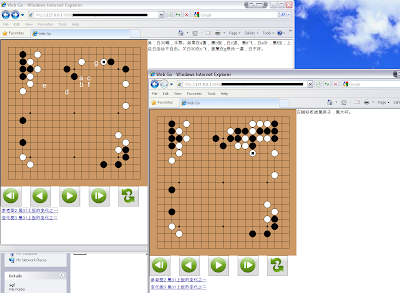- No software installation required. It only needs a web browser.
- An unique system that makes it easy to navigate within a game. Variations displayed as hyper links.
- An unique mechanism that displays comments intuitively. Comments keep synchronized with actual game progress that is being displayed on the board.
- Group-based access control. Bloggers control which part of contents (text and games included) can be read/viewed, or a published game can be downloaded or only viewed on-line based on granted groups.
- A Game can be embed into third-party web pages or blogs(See example:My previous post http://supportmobilego.blogspot.com/2011/07/test.html).
- Multilingual blogs supported. Bloggers can easily publish their posts in different languages, readers can easily read in their desire language. Localized administrator’s dashboards are also provided.
- There are more. Just try it out and you will be surprised and spoiled.
Support Mobile Go
Mobile Go is a client software running on mobile devices for board game Go碁 (Weiqi圍棋,围棋, Baduk바둑) servers including popular IGS, LGS, CWS and WING. You can observe or play game with it as long as your mobile device can access Internet. Mobile Go was designed to support most IGS and NNGS commands. Play Go on the go with Mobile Go.
Tuesday, 5 February 2013
Introducing UNIWEBGO
Friday, 15 July 2011
Friday, 15 April 2011
Tuesday, 1 March 2011
Study of Navigation in Reviewing A Go Game
Use case 1
Id: UC01
Name: Level 0
Scenario: There is no variation at all. There are only comments, marks and labels.
Scope: Original or light commentary games
Commands required:
Basic navigation commands
- Next move - NM
- Previous move - PM
- End of game - EG
- Beginning of game - BG
- Fast forward - FF
- Fast rewind - FW
- Go to arbitrary move - GM
Use case 2
Id: UC02
Name: Level 1
Scenario: There are variations on main path. There is no variation on variations.
Scope: Most commentary games
Commands required: Basic navigation commands plus following commands (Variation Commands):
- Next variation - NV
- Previous variation - PV
- Back to nearest fork of variations- BF
- Go to arbitrary variation - GV
Notes on command: Suppose the game tree looks like
A – B – C – D
––B’– C’– D’
––B”– C”–D”
- NV can be applied from node {A, B, C, D} to node B’, or it can be applied from node {B’, C’, D’} to node B”;
- PV can be applied from node {B”, C”, D”} to node B’, or it can be applied from node {B’, C’, D’} to node B;
- BF can be applied from node {B, C, D, B’, C’, D’, B”, C”, D”} to node A
Use case 3
Id: UC03
Name: Level 2
Scenario: There are variations on variation.
Scope: Joseki(定式), death and live
Commands required: Basic navigation commands, Variation commands
Use case 4
Id: UC04
Name: Level +
Scenario: There are comments that reference an arbitrary node in either main path or variations
Scope: Joseki or heavily commentary games
Commands required: Basic navigation commands, Variation commands and following Node referencing command
- Go to arbitrary node – GN
- Previous node – PN: It goes back to the node where a “Go to …” command executed.
- Next node – NN: It is the opposite command of PN from the history of navigation point of view. It goes forward through navigation history.
Explain: Suppose the navigation history looks like
A – B – C, from oldest to newest
- If we are currently at node B, NN takes us to node C and PN takes us to node A;
- If we are current at node C, NN does nothing and PN takes us to node B;
- If we are current at node A, NN takes us to node B and PN does nothing.
Friday, 14 January 2011
Mobile Go Revived
Enthusiasts' voices should never be ignored. Stay tuned.
Wednesday, 9 December 2009
Stop Working On Mobile Go
Bye.
Tuesday, 9 June 2009
About Game Protocol
Since EGGP is based on Go Text Protocol (GTP) version 2 draft 2, which is GNU open source, I will release EGGP under GNU later as well.



